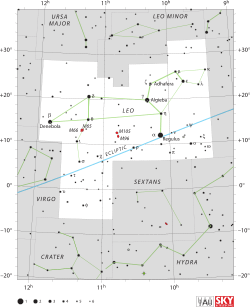Theta Leonis

Location of θ Leonis (circled) | |
| Observation data Epoch J2000.0 Equinox J2000.0 | |
|---|---|
| Constellation | Leo |
| Right ascension | 11h 14m 14.40446s[1] |
| Declination | +15° 25′ 46.4541″[1] |
| Apparent magnitude (V) | +3.324[2] |
| Characteristics | |
| Spectral type | A2 V[3] |
| U−B color index | +0.07[2] |
| B−V color index | –0.02[2] |
| Astrometry | |
| Radial velocity (Rv) | +7.6[4] km/s |
| Proper motion (μ) | RA: -60.31[1] mas/yr Dec.: -79.10[1] mas/yr |
| Parallax (π) | 19.76 ± 0.17[1] mas |
| Distance | 165 ± 1 ly (50.6 ± 0.4 pc) |
| Details | |
| Mass | 2.5[5] M☉ |
| Luminosity | 141[5] L☉ |
| Surface gravity (log g) | 3.65[6] cgs |
| Temperature | 9,350[6] K |
| Metallicity [Fe/H] | +0.05[6] dex |
| Rotational velocity (v sin i) | 23[7] km/s |
| Age | 550[6] Myr |
| Other designations | |
Theta Leonis (θ Leo, θ Leonis) is a star in the constellation Leo. It has the traditional names Chertan, Chort and Coxa.[9] With an apparent visual magnitude of +3.324[2] it is visible to the naked eye and forms one of the brighter stars in the constellation. The distance from Earth can be directly determined from parallax measurements, yielding a value of about 165 light-years (51 parsecs).[1]
This is a large star with 2.5 times the mass of the Sun.[5] The spectrum matches a stellar classification of A2 V,[3] making this a seemingly typical A-type main sequence star. However, the spectrum shows enhanced absorption lines of metals, marking this as a chemically peculiar Am star.[10] The abundance of elements other than hydrogen and helium, what astronomers term the star's metallicity, appears around 12% higher than in the Sun.[6] It is radiating 141[5] times the luminosity of the Sun from its outer atmosphere at an effective temperature of 9,350 K,[6] literally giving it a white-hot glow.[11]
Theta Leonis is much younger than the Sun, with an estimated age of around 550 million years.[6] It has a moderately high rate of rotation, with a projected rotational velocity of 23 km s–1.[7] Measurements in the infrared band show an excess of emission from the star and its surroundings, suggesting the presence of a circumstellar disk of dust. The temperature of this emission indicates the disk has an orbital radius of 36 AU.[6]
Etymology
This star has the following traditional names:
- Chertan (from Arabic al-kharātān = "two small ribs", originally referring to δ and θ Leonis)
- Chort (from Arabic al-kharāt or al-khurt = "small rib")
- Coxa (Latin for "hip")
References
- ↑ 1.0 1.1 1.2 1.3 1.4 1.5 van Leeuwen, F. (November 2007), "Validation of the new Hipparcos reduction", Astronomy and Astrophysics 474 (2): 653–664, arXiv:0708.1752, Bibcode:2007A&A...474..653V, doi:10.1051/0004-6361:20078357
- ↑ 2.0 2.1 2.2 2.3 Johnson, H. L. et al. (1966), "UBVRIJKL photometry of the bright stars", Communications of the Lunar and Planetary Laboratory 4 (99), Bibcode:1966CoLPL...4...99J
- ↑ 3.0 3.1 Cowley, A. et al. (April 1969), "A study of the bright A stars. I. A catalogue of spectral classifications", Astronomical Journal 74: 375–406, Bibcode:1969AJ.....74..375C, doi:10.1086/110819
- ↑ Wielen, R. et al. (1999), Sixth Catalogue of Fundamental Stars (FK6). Part I. Basic fundamental stars with direct solutions (35), Astronomisches Rechen-Institut Heidelberg, Bibcode:1999VeARI..35....1W
- ↑ 5.0 5.1 5.2 5.3 Wyatt, M. C. et al. (July 2007), "Steady State Evolution of Debris Disks around A Stars", The Astrophysical Journal 663 (1): 365–382, arXiv:astro-ph/0703608, Bibcode:2007ApJ...663..365W, doi:10.1086/518404
- ↑ 6.0 6.1 6.2 6.3 6.4 6.5 6.6 6.7 Smith, K. C.; Dworetsky, M. M. (1993), "Elemental Abundances in Normal Late B-Stars and Hgmn-Stars from Co-Added IUE Spectra - Part One - Iron Peak Elements", Astronomy and Astrophysics 274 (2): 335, Bibcode:1993A&A...274..335S
- ↑ 7.0 7.1 Royer, F.; Zorec, J.; Gómez, A. E. (February 2007), "Rotational velocities of A-type stars. III. Velocity distributions", Astronomy and Astrophysics 463 (2): 671–682, arXiv:astro-ph/0610785, Bibcode:2007A&A...463..671R, doi:10.1051/0004-6361:20065224
- ↑ "tet Leo -- Variable Star", SIMBAD (Centre de Données astronomiques de Strasbourg), retrieved 2012-02-11
- ↑ Burnham, Robert (1978), Burnham's celestial handbook: an observer's guide to the universe beyond the Solar System, Dover Books on Astronomy 2 (2nd ed.), Courier Dover Publications, p. 1067, ISBN 0-486-23568-8
- ↑ Netopil, M. et al. (November 2008), "Chemically peculiar stars and their temperature calibration", Astronomy and Astrophysics 491 (2): 545–554, arXiv:0809.5131, Bibcode:2008A&A...491..545N, doi:10.1051/0004-6361:200810325
- ↑ "The Colour of Stars", Australia Telescope, Outreach and Education (Commonwealth Scientific and Industrial Research Organisation), December 21, 2004, retrieved 2012-01-16
| ||||||||||||||||||||||||||